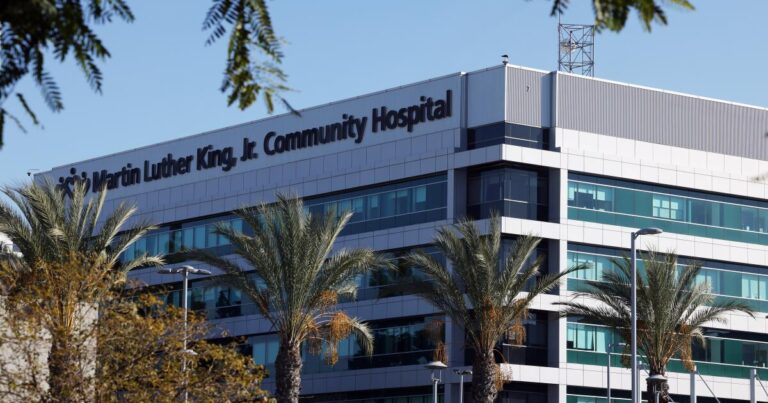Martin Luther King Jr. Group Hospital is the cornerstone of Los Angeles County’s public funding within the well being and well-being of thousands and thousands of residents who’ve few different choices for medical care. The non-public facility has been a outstanding success because it opened 8½ years in the past, changing a infamous public hospital that closed after an infinite collection of medical and administration failures.
Now the brand new hospital can be at risk, not due to the standard of medical care or administration, each of which have obtained wonderful opinions.
The issue is a funding construction that depends on supplemental funds from the state and county however would not account for inflation. The hospital can be a sufferer of its personal irreplaceable function in society. So many South LA County residents are uninsured or underinsured and subsequently do not go to outpatient clinics — few of which exist within the underserved a part of the county anyway — that their medical circumstances worsen till they should go to the hospital.
MLK’s emergency division serves almost 4 instances as many sufferers — typically 400 a day — because the 110 day by day visits anticipated when the hospital opened in 2015. The shortage of insurance coverage and reimbursements resulted in a $42 million loss within the finances 12 months that led to June.
Restructuring the supplementary funds must be a no brainer, other than two obstacles. First, California now not enjoys surplus income, and certainly Governor Gavin Newsom vetoed a 2022 invoice that may have offered an necessary ongoing financial increase.
And secondly, reminiscences are quick. So quick, actually, {that a} new era of legislators (even these representing the hospital’s service space) might have forgotten what a catastrophe it was for his or her constituents to be mistreated by the previous hospital after which left untreated in the course of the decade between its closure and the opening of the brand new facility.
So some reminders are so as. The previous hospital, formally referred to as Martin Luther King Jr./Charles Drew Medical Heart (and informally as “Killer King”), opened in Willowbrook in 1971 within the wake of the unrest following King’s assassination in 1968. Its building and operation by Los Angeles County was a recognition of the stunning lack of primary medical care in what was then a largely black neighborhood.
The hospital grew to become notably identified for its trauma unit, which handled a disproportionate variety of victims of gun violence.
However insufficient county oversight and administration contributed to low requirements of care and eventual closure in 2007. It was the nation’s largest county authorities — and the state’s — most constant failure to reside as much as their primary tasks to voters.
The plan to exchange it and return first-class medical service to the neighborhood was a stroke of genius. The brand new hospital is privately run, eliminating among the administration issues that arose when medical workers who didn’t meet skilled requirements had been protected by the county civil service system. However it was constructed with county funding on county land. Physicians are offered by College of California campuses. The ability is positioned on a medical campus that features quite a lot of complementary county-run well being companies, a few of that are state-of-the-art, together with acute medical care, psychiatric acute care, a short-term restoration or “sober” middle, leisure therapy and a public well being middle.
Collectively, these and different companies characterize the sort of funding in public well being, psychological well being and medical care that county authorities has made the inspiration of its “care first” mission for the previous decade. The state ought to help these investments with its personal commitments.
The county supervisory authority submitted a proposal on Tuesday to shortly think about choices to maintain the hospital afloat. State lawmakers ought to do the identical once they reconvene in January for the second 12 months of their two-year session. There are lots of competing pursuits vying for a slice of the state’s tight finances, however important medical companies for thousands and thousands of Southern Californians must be at or close to the highest of the checklist.

